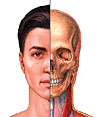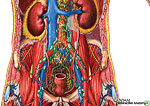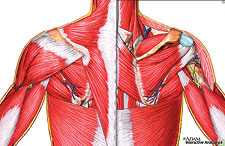Inside UAB’s Virtual Anatomy Lab
 Anyone who’s taken a course in human anatomy knows the smell of formaldehyde—probably better than they’d like to. Could there ever be an anatomy class without the cadaver? UAB’s new anatomy lab in Campbell Hall is equipped with technology that is making the idea seem less and less far-fetched.
Anyone who’s taken a course in human anatomy knows the smell of formaldehyde—probably better than they’d like to. Could there ever be an anatomy class without the cadaver? UAB’s new anatomy lab in Campbell Hall is equipped with technology that is making the idea seem less and less far-fetched.
“We’ve been trying to get the ADAM (Animated Dissection of Anatomy for Medicine) software since it was first developed in 1997,” says biologist Leslie Hendon, Ph.D., who teaches anatomy to undergraduates at UAB. “We had no computers in our anatomy lab until the summer of ’99, when we got a grant that covered the cost of the ADAM software and the hardware to use it.”
The ADAM Interactive Anatomy software allows students to dissect a stylized cadaver, layer by layer, on their computer screens. Different areas of the body can be dissected to different depths, and computerized, three-dimensional structures can be rotated and taken apart. The program also includes hundreds of drawings and photographs of actual organs.
 When asked whether or not the software will completely replace physical cadaver work, Hendon says, “Sadly, I think it could. Many schools are going more digital for their cadaver section.” But the fact that it is now possible to trade cadavers for computers doesn’t necessarily mean it’s the best thing to do. “Personally,” she says, “I think there is nothing like a real cadaver to get students immersed in the class.” UAB’s ability to offer both cadaver work and top-notch anatomy software at the undergraduate level is one thing that makes it competitive among its neighboring universities, she adds.
When asked whether or not the software will completely replace physical cadaver work, Hendon says, “Sadly, I think it could. Many schools are going more digital for their cadaver section.” But the fact that it is now possible to trade cadavers for computers doesn’t necessarily mean it’s the best thing to do. “Personally,” she says, “I think there is nothing like a real cadaver to get students immersed in the class.” UAB’s ability to offer both cadaver work and top-notch anatomy software at the undergraduate level is one thing that makes it competitive among its neighboring universities, she adds.
Students who take anatomy classes through the Department of Biology buy their own ADAM software for about $125. Hendon says the biggest plus of the software, which she thinks students occasionally overlook, is that it is something that can be used indefinitely. ADAM Interactive allows students to learn the names of biological structures and gain deeper understanding of their relationships to one another. Hendon also credits it with precisely illustrating processes, such as blood flow, that would be abstract in cadaver studies.
 One of the software’s main goals is to promote a practical understanding of human anatomy outside of the classroom. Hendon says, “Anatomical knowledge enables us to understand detailed medical information that we may get from our doctors. We can all receive better medical care by having a better understanding of our bodies.”
One of the software’s main goals is to promote a practical understanding of human anatomy outside of the classroom. Hendon says, “Anatomical knowledge enables us to understand detailed medical information that we may get from our doctors. We can all receive better medical care by having a better understanding of our bodies.”
—Takeshia Long